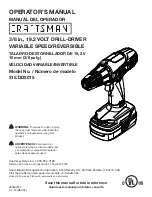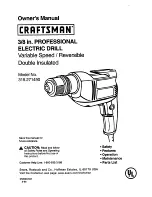
7
Installation
SELECTING A LOCATION
This barbecue is for outdoor use only and should be placed in
a well-ventilated area. Take care to ensure that the minimum
clearances guidelines are followed:
Minimum clearances:
From sides: 430mm; From back: 430mm
From above (vertical): 1000mm
Keep this barbecue away from any flammable materials! This
appliance shall only be used in an above ground open-air situation
with natural ventilation, without stagnant areas, where gas leakage
and products of combustion are rapidly dispersed by wind and
natural convection. This barbecue is not designed for marine use.
Any enclosure in which the appliance is used shall comply with one
of the following:
1. An enclosure with walls on all sides, but at least one permanent
opening at ground level and no overhead cover.
2. Within a partial enclosure that includes an overhead cover and
no more than two walls.
3. Within a partial enclosure that includes an overhead cover and
more than two walls, the following shall apply:
a)
at least 25% of the total wall area is completely
open and unrestricted
b)
at least 30% of the remaining wall area is open
and unrestricted
4. In the case of balconies, at least 20% of the total of the side,
back and front wall areas shall be and remain open and
unrestricted.
See following diagrams for further illustration:
FIGURE F2-OUTDOOR AREA-EXAMPLE 2
FIGURE F1-OUTDOOR AREA-EXAMPLE 1
30 percent or more in total
of the remaining wall area is
open and unrestricted
Open side at
least 25% of total
wall area
Both ends open
30 percent or more in total
of the remaining wall area is
open and unrestricted
Open side at
least 25% of total
wall area
FIGURE F5-OUTDOOR AREA-EXAMPLE 5
FIGURE F4-OUTDOOR AREA-EXAMPLE 4
FIGURE F3-OUTDOOR AREA-EXAMPLE 3
Before proceeding, you need to establish the gas type which
your barbecue will run on, and the style of installation you
need.
NATURAL GAS OR ULPG
Before beginning installation or assembly, check that the gas type
which the barbecue is designed for is correct for the gas available
to you. In most countries the choices are natural gas or ULPG.
You will find the gas type label on the side of your barbecue. If your
barbecue uses the incorrect gas type, or if you are unsure, consult
your dealer before going any further. Using the wrong type of
gas for a barbecue is extremely dangerous.
Natural Gas Conversion
: Most newly purchased barbecues are
made for ULPG. A natural gas conversion kit is available to allow
your barbecue to run on natural gas.
FIXED (PIPED) INSTALLATIONS
Piped Natural Gas
: Although installation costs are higher, this is
typically the least expensive way to run your barbecue. Natural gas
is delivered via pipeline to a gas meter near the
perimeter of your home. From the gas meter, gas is taken by a
further series of pipes to each appliance that uses natural gas.
Piped ULPG
: Some properties do not have natural gas available to
them. In these cases, the local gas supply company may be able
to provide two 45 Kg (100 lb) cylinders permanently installed on the
outside of your home. These are refilled for you by the gas company
based on your usage patterns. Copper pipe is then run from these
cylinders to each appliance that
uses ULPG.
There are two methods of connecting the gas to your barbecue,
both of which require the services of a licensed gas fitter:
•
For built in (ie non-mobile) installations, the barbecue inlet
can be connected directly to copper piping. From here the
barbecue cannot be moved.


































